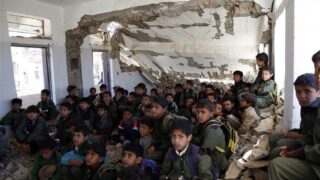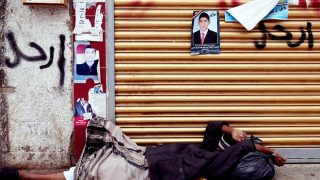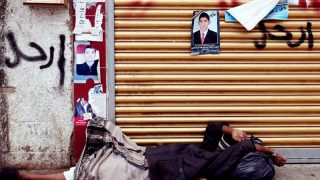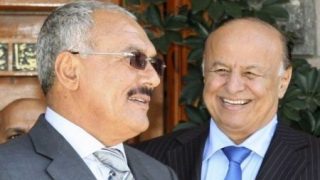On April 10, 2013, Abd-Rabbu Mansour Hadi, the caretaker president of the Republic of Yemen, made the decision to ban General Ahmed Ali Abdullah Saleh from the leadership of the Republican Guard (and appointed him ambassador to the UAE). It also excluded General Ali Mohsen al-Ahmar from the leadership of the First Armored Division (appointing him as advisor to the president of the republic for defense and security affairs). The president appointed leaders to the seven military zones that had been divided by a resolution issued in December 2012. He also took the decision to redeploy the First Armored Division forces outside the capital of Sanaa and to transform the camp in the capital to a public park.
He was able to do all of this after two years of objections by labor forces from the old regime as well as the traditional forces who [supposedly] “stood behind” the revolution. The concluding statement from the first work session at the National Dialogue Conference (which was held from March 18 until April 3) described a new balance for these forces. He reiterated all the issues for which the civil forces fought since the beginning of the revolution in February 2011, first and foremost being the structure of the army, drafting a balance of the new forces that was carried out deliberately and in the midst of conflicts.
Youth Revolution
When the deputy general secretary of the ruling party (Sultan al-Barkani) announced the party’s desire at the end of December 2010 to end the limit on number of presidential terms, or to “remove the meter” as he put it, the general feeling throughout the Yemeni public was that a revolution must be carried out against the regime to topple (or “remove”!) it through a popular uprising.
The students from Sanaa University formed a crucial bloc for just such a revolution. The student organization from the Yemeni Socialist Party at the Sanaa University announced a revolution against the regime in a statement just days after the declaration at the beginning of 2011, which came to be known as the “students’ revolution.” In the course of three weeks, the students were able to mobilize the civil forces in general and the youth in particular to announce a revolution against the regime. It started in Taiz city’s freedom square and the youth revolution has continued to be the inherent name of the Yemeni revolution up until today, in spite of the participation of the Yemeni public of all ages and social, political and ideological strata in the squares of freedom and the plazas of change established by the youth in 17 governorates across Yemen. At the same time, people from the south withdrew from their demands for “secession” and replaced it with chants of “the people want to topple the regime”.
A square for freedom and a plaza for change was set up in every southern governorate and youth from “Ansar Allah” or the Houthi movement joined in the revolution. On March 21, 2011, the historical revolutionary bloc was completed when the religious, tribal, military and political elites proclaimed their support for it (without joining with it in solidarity). Every square or plaza for freedom and change turned into an opportunity for these elites, racing to their podiums to declare that they were not affiliated with the regime, did not espouse its ideas, practices and projects as they delivered speeches of praise for the youth and the civil forces. In confirmation of the role of the youth and civil forces in the revolution, the elites proudly used the term “youth revolution,” calling themselves “proponents of the revolution”. They vowed to protect the youth of the revolution and support their cause in order to topple the regime and build a modern, civil democratic state.
When the former president accused these traditional elites of hijacking the revolution from the youth, some swore in anger that they had not done so. General Mohsen al-Ahmar pledged to retire after the regime fell and to turn the 1st Armored Division camp into a public park. When the former president Ali Abdullah Saleh coordinated a simultaneous exit from Yemen [with] Gen. Mohsen al-Ahmar and Sheikh Sadeq al-Ahmar, the latter two agreed, improving the confidence of the civil forces that the revolution would inevitably be victorious. It also strengthened their belief that the only way to topple the regime is through a popular uprising, prompting them to chant: “No negotiations or dialogue / resign or flee," channeling the words of the Italian intellectual, Antonio Gramshi on the “War of Movement”. This was in light of the success of the Egypt public in forcing Hosni Mubarak to resign and Zein Abeddine Ben Ali to flee when the throngs of the Tunisian revolution reached the capital city of Tunis.
Speeches of intentions alone do not suffice
In spite of speeches [promising] good intentions wherein the traditional elites announced their support for the revolution, which they continue to embellish today, and their feigned lamentations over the lack of youth representation at the entire National Dialogue conference, in practice they have granted themselves a mandate over the revolution and excluded the youth from decision-making. Since the first week when they announced their support for the revolution, they negotiated in its name with those who remained of the regime, with [political] actors and regional and international intermediaries without speaking with the youth of the revolution or the civilian forces. They signed the Gulf initiative and the measures of its implementation without being commissioned [to do so] by the revolutionaries in the squares of freedom and the plazas of change.
Nay, these elites took to practicing certain kinds of hegemony and control (either directly or indirectly) over the revolutionary protest marches. They banned any march from entering al-Zebiri Street, which had come to represent a dividing boundary between northern Sanaa, where the forces and militias of the “proponents of the revolution” were in control, and southern Sanaa, which was in the hands of forces and militias of the “remains of the [old] regime.” They prevented the participation of the “silks” (or women) from revolutionary marches.
The developments during the transitional period revealed that announcing attentions alone is not sufficient. The revolution began to suffer from double-resistance—one from the outside, lead by the remains of the family regime, and the other from within, lead by the traditional elites who wished to bring down certain people from the regime. The latter also sought to protect their institutions and legislation, exploiting them for personal gain. Since the signing of this Gulf initiative and its procedures of implementation, as well as holding consensual presidential elections that brought Abd-Rabbu Mansour Hadi to the president’s seat, some of these elites went back on their promises to the revolution, racing to fill the vacuum left in certain locations of power in civil and military institutions by some of the former regime.
They also resisted any change in their loyalties in them, especially in the military institutions, to the extent where it began to face obstacles in finalizing the structure of the armed forces, precisely like the remaining [elements] of the regime resist it. They used the same methods as the old regime in breaking up society in order to guarantee that they and those loyal to them would remain in places of power and protect their political interests, which has fueled confessional, sectarian and regional conflicts.
These changes redrew the map of the distribution of political and military force, just as it reorganized the issues of conflict between different sides of the Yemeni political regime. The conflict is no longer merely between a historic bloc of revolution forces and remnants of the regime. A certain divergence and conflict has become apparent among certain revolutionary forces, as well as between different parts of the former regime. Some youth were excluded from the leadership of the revolution forces, to be replaced by political, tribal and military elites. Some of the revolutionaries began to accuse others of forming alliances with the former president or at least coordinating with him. They began to act according to reactionary and antagonistic logic to the detriment of the goals of the revolution.
The “consensual” president, Abd-Rabbu Mansour Hadi, has become a target for pressures from all divisions, not to mention blackmail coming from such sides as the proponents of the revolution. All of his decisions are met with objection or criticism by one of the political sides. When the president issued a bunch of resolutions concerning the structure of the armed forces in December 2012, everyone proclaimed their commitment to them and their willingness to implement them unconditionally. However, in practice, they reacted to them with objection and rebellion, be they from the former regime or proponents of the revolution. The reactions of these forces to the president’s appointment of civilian officials were no different.
Sanaa or bust, no matter how long the trip
“Sanaa or bust, no matter how long the trip.” This is an express usually repeated by Yemenis in reaction to the [daily] challenges, obstacles and difficulties they face. It would [now] seem that his age-old expression has become a slogan for the civil forces. The developments seen in Yemen in 2012 generated a conviction among them that the path to realizing the goals of the revolution is long, and that the Gulf initiative that they had refused may achieve for the revolution what it was unable to by toppling the regime through a popular uprising and create a uniquely Yemeni model among the Arab Spring revolutions.
In spite of how slowly the transitional period’s tasks have been implemented, which may entail extending [the term of] the consensual president and delaying presidential and parliamentary elections, the civil forces have been able to achieve partial gains. In light of the social structure, cultural frameworks, political circumstances and existing economic situation in Yemen, the “slow revolution” is becoming the most guaranteed way to democratic transition and building a civil state.
This is what the civil forces have come to after more than two years of revolution. They have become convinced that quickly toppling the regime through a popular uprising merely paved the way to replace the dictatorial regime with another dictatorial regime. The military dictatorship was replaced with a tribal or confessional dictatorship, or even another military one. This is especially the case if the traditional elites both within and outside of the regime are able to disrupt any peaceful trajectory for the revolution. This is also the case if the “proponents of the revolution” are able to drag the regime, or if it is able to drag them, into a military confrontation before it falls. Both sides were aiming for this, if it were not for the explosion at the mosque of the presidential residence where the former president was injured.
Two balanced trajectories
Ever since the civil forces signed the Gulf initiative and its executive procedures, which have granted the former president free legal and judicial amnesty, it has become apparent to the revolutionary forces that the “slow revolution” is the most appropriate for the establishment of a civil state. The traditional social structure is still active and effective, just as the tribal balance, social relations and patronage politics still remain powerful as barriers standing in the way of achieving the goals of the revolution. This requires [the modern civil forces] to work with two balanced trajectories: one political and one social. In other words, the revolution’s political trajectory to change the political regime, and its social trajectory to change the social foundations and relationships, participating in the formation of modern civil social and political awareness.
Voices have appeared in support of the efforts of the civil forces during the first general session of the National Dialogue Conference, where members of the conferences were divided into two sides. The traditional forces drew together from all inclinations and tendencies, just as the civil forces in their different political, ideological and confessional leanings came together. The youth and the civil forces were able to make important gains in the labor presidential elections, qualified to hold considerable sway over the decision-making process during the conference that lasted for a month as a “transitional tool.”
The resolutions that President Hadi was able to issue influence this session and its statement, constituting an important formative step in the field of building a civil state. The centers of the military forces at one time posed one of the greatest obstacles over the past three decades.
Translated by Al-Monitor






